The Role of Surveillance in Modern Policing: A Criminology Report
VerifiedAdded on 2020/01/23
|105
|41475
|66
Report
AI Summary
This report delves into the multifaceted world of police surveillance, exploring its various methods, theoretical underpinnings, and real-world applications. It begins by outlining different surveillance techniques, including electronic monitoring, fixed surveillance, and undercover operations. The report then examines the positive aspects of surveillance, such as its role in crime detection and reduction, while also acknowledging the importance of accountability and transparency. Furthermore, it discusses relevant theories like Marxism and Michel Foucault's theory, providing a critical perspective on the social and ethical implications of surveillance. The report also presents case studies, such as the use of infiltration by undercover police officers, to illustrate the complexities and controversies surrounding surveillance practices. Finally, the report considers the impact of surveillance on police behavior and its role in the criminal justice system, including the use of body cameras and CCTV footage as evidence. The report concludes by highlighting the importance of balancing the benefits of surveillance with the need to protect individual rights and prevent abuse of power.
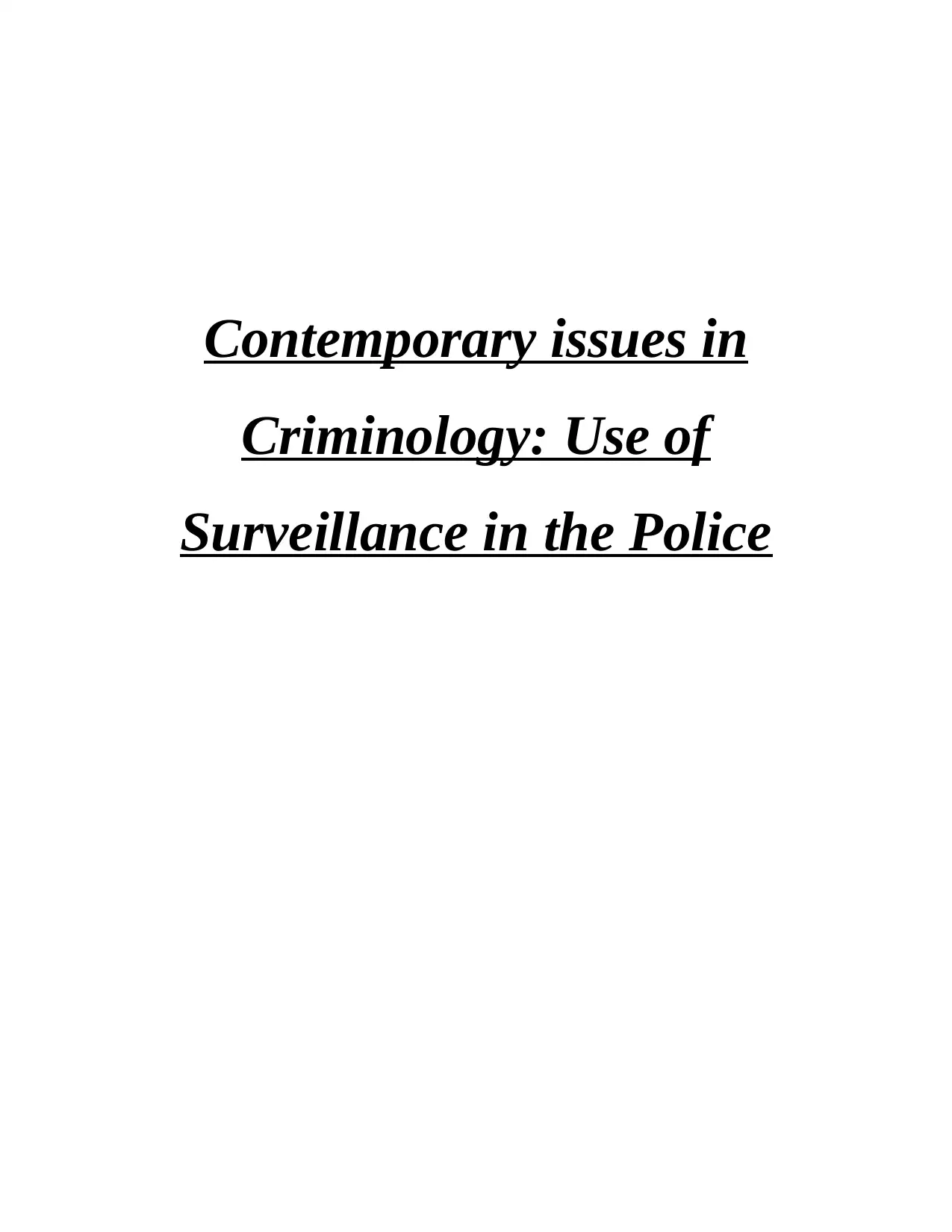
Contemporary issues in
Criminology: Use of
Surveillance in the Police
Criminology: Use of
Surveillance in the Police
Paraphrase This Document
Need a fresh take? Get an instant paraphrase of this document with our AI Paraphraser
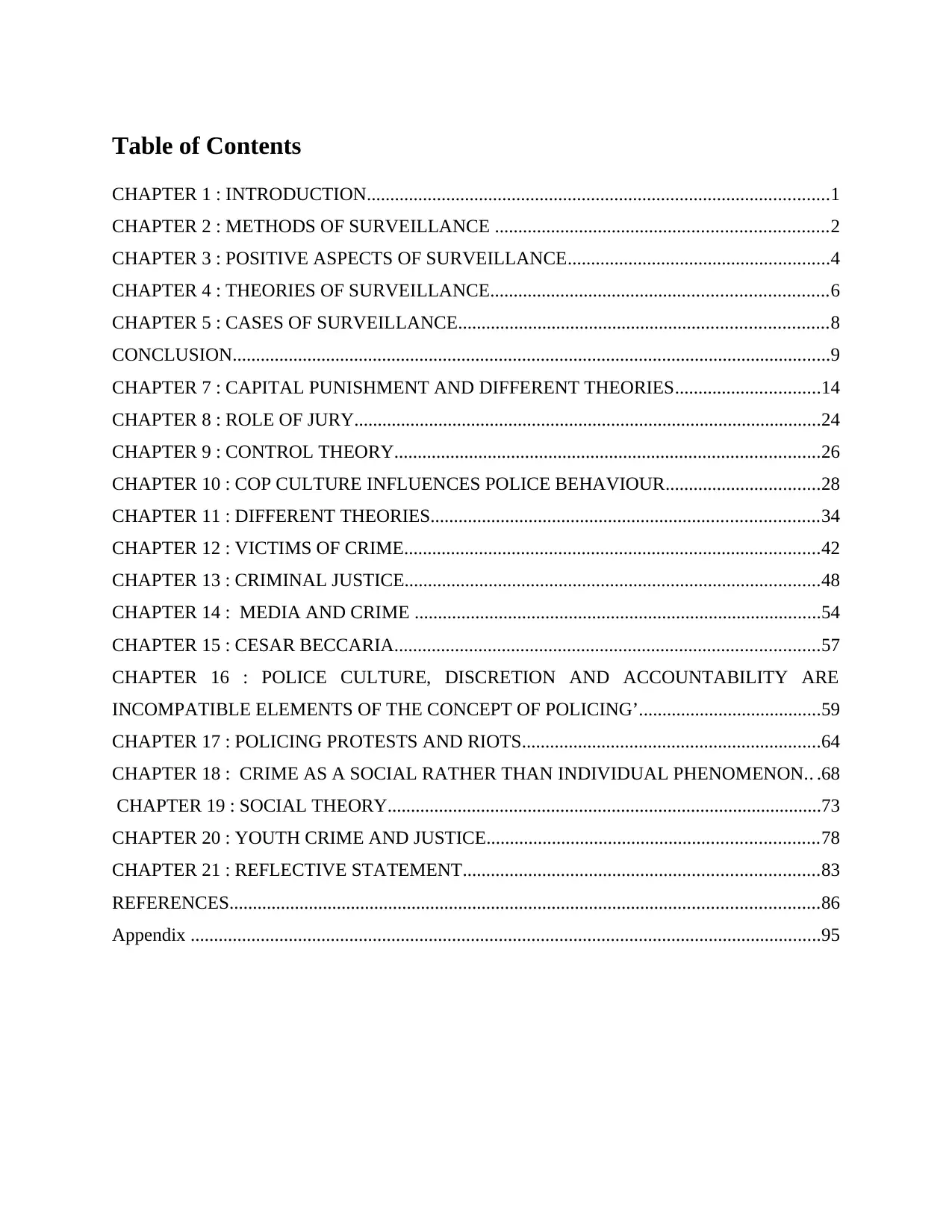
Table of Contents
CHAPTER 1 : INTRODUCTION...................................................................................................1
CHAPTER 2 : METHODS OF SURVEILLANCE .......................................................................2
CHAPTER 3 : POSITIVE ASPECTS OF SURVEILLANCE........................................................4
CHAPTER 4 : THEORIES OF SURVEILLANCE........................................................................6
CHAPTER 5 : CASES OF SURVEILLANCE...............................................................................8
CONCLUSION................................................................................................................................9
CHAPTER 7 : CAPITAL PUNISHMENT AND DIFFERENT THEORIES...............................14
CHAPTER 8 : ROLE OF JURY....................................................................................................24
CHAPTER 9 : CONTROL THEORY...........................................................................................26
CHAPTER 10 : COP CULTURE INFLUENCES POLICE BEHAVIOUR.................................28
CHAPTER 11 : DIFFERENT THEORIES...................................................................................34
CHAPTER 12 : VICTIMS OF CRIME.........................................................................................42
CHAPTER 13 : CRIMINAL JUSTICE.........................................................................................48
CHAPTER 14 : MEDIA AND CRIME .......................................................................................54
CHAPTER 15 : CESAR BECCARIA...........................................................................................57
CHAPTER 16 : POLICE CULTURE, DISCRETION AND ACCOUNTABILITY ARE
INCOMPATIBLE ELEMENTS OF THE CONCEPT OF POLICING’.......................................59
CHAPTER 17 : POLICING PROTESTS AND RIOTS................................................................64
CHAPTER 18 : CRIME AS A SOCIAL RATHER THAN INDIVIDUAL PHENOMENON.. .68
CHAPTER 19 : SOCIAL THEORY.............................................................................................73
CHAPTER 20 : YOUTH CRIME AND JUSTICE.......................................................................78
CHAPTER 21 : REFLECTIVE STATEMENT............................................................................83
REFERENCES..............................................................................................................................86
Appendix .......................................................................................................................................95
CHAPTER 1 : INTRODUCTION...................................................................................................1
CHAPTER 2 : METHODS OF SURVEILLANCE .......................................................................2
CHAPTER 3 : POSITIVE ASPECTS OF SURVEILLANCE........................................................4
CHAPTER 4 : THEORIES OF SURVEILLANCE........................................................................6
CHAPTER 5 : CASES OF SURVEILLANCE...............................................................................8
CONCLUSION................................................................................................................................9
CHAPTER 7 : CAPITAL PUNISHMENT AND DIFFERENT THEORIES...............................14
CHAPTER 8 : ROLE OF JURY....................................................................................................24
CHAPTER 9 : CONTROL THEORY...........................................................................................26
CHAPTER 10 : COP CULTURE INFLUENCES POLICE BEHAVIOUR.................................28
CHAPTER 11 : DIFFERENT THEORIES...................................................................................34
CHAPTER 12 : VICTIMS OF CRIME.........................................................................................42
CHAPTER 13 : CRIMINAL JUSTICE.........................................................................................48
CHAPTER 14 : MEDIA AND CRIME .......................................................................................54
CHAPTER 15 : CESAR BECCARIA...........................................................................................57
CHAPTER 16 : POLICE CULTURE, DISCRETION AND ACCOUNTABILITY ARE
INCOMPATIBLE ELEMENTS OF THE CONCEPT OF POLICING’.......................................59
CHAPTER 17 : POLICING PROTESTS AND RIOTS................................................................64
CHAPTER 18 : CRIME AS A SOCIAL RATHER THAN INDIVIDUAL PHENOMENON.. .68
CHAPTER 19 : SOCIAL THEORY.............................................................................................73
CHAPTER 20 : YOUTH CRIME AND JUSTICE.......................................................................78
CHAPTER 21 : REFLECTIVE STATEMENT............................................................................83
REFERENCES..............................................................................................................................86
Appendix .......................................................................................................................................95
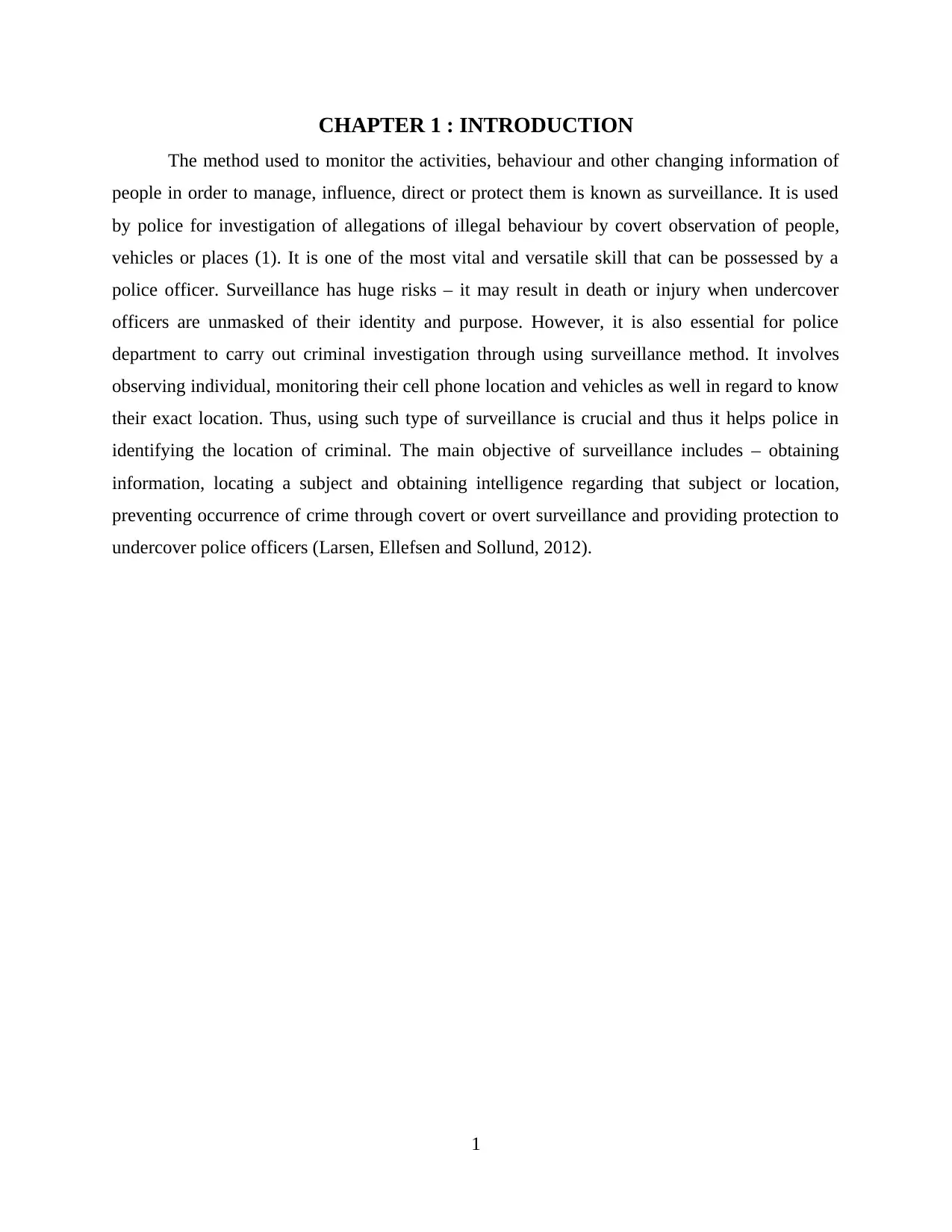
CHAPTER 1 : INTRODUCTION
The method used to monitor the activities, behaviour and other changing information of
people in order to manage, influence, direct or protect them is known as surveillance. It is used
by police for investigation of allegations of illegal behaviour by covert observation of people,
vehicles or places (1). It is one of the most vital and versatile skill that can be possessed by a
police officer. Surveillance has huge risks – it may result in death or injury when undercover
officers are unmasked of their identity and purpose. However, it is also essential for police
department to carry out criminal investigation through using surveillance method. It involves
observing individual, monitoring their cell phone location and vehicles as well in regard to know
their exact location. Thus, using such type of surveillance is crucial and thus it helps police in
identifying the location of criminal. The main objective of surveillance includes – obtaining
information, locating a subject and obtaining intelligence regarding that subject or location,
preventing occurrence of crime through covert or overt surveillance and providing protection to
undercover police officers (Larsen, Ellefsen and Sollund, 2012).
1
The method used to monitor the activities, behaviour and other changing information of
people in order to manage, influence, direct or protect them is known as surveillance. It is used
by police for investigation of allegations of illegal behaviour by covert observation of people,
vehicles or places (1). It is one of the most vital and versatile skill that can be possessed by a
police officer. Surveillance has huge risks – it may result in death or injury when undercover
officers are unmasked of their identity and purpose. However, it is also essential for police
department to carry out criminal investigation through using surveillance method. It involves
observing individual, monitoring their cell phone location and vehicles as well in regard to know
their exact location. Thus, using such type of surveillance is crucial and thus it helps police in
identifying the location of criminal. The main objective of surveillance includes – obtaining
information, locating a subject and obtaining intelligence regarding that subject or location,
preventing occurrence of crime through covert or overt surveillance and providing protection to
undercover police officers (Larsen, Ellefsen and Sollund, 2012).
1
⊘ This is a preview!⊘
Do you want full access?
Subscribe today to unlock all pages.

Trusted by 1+ million students worldwide
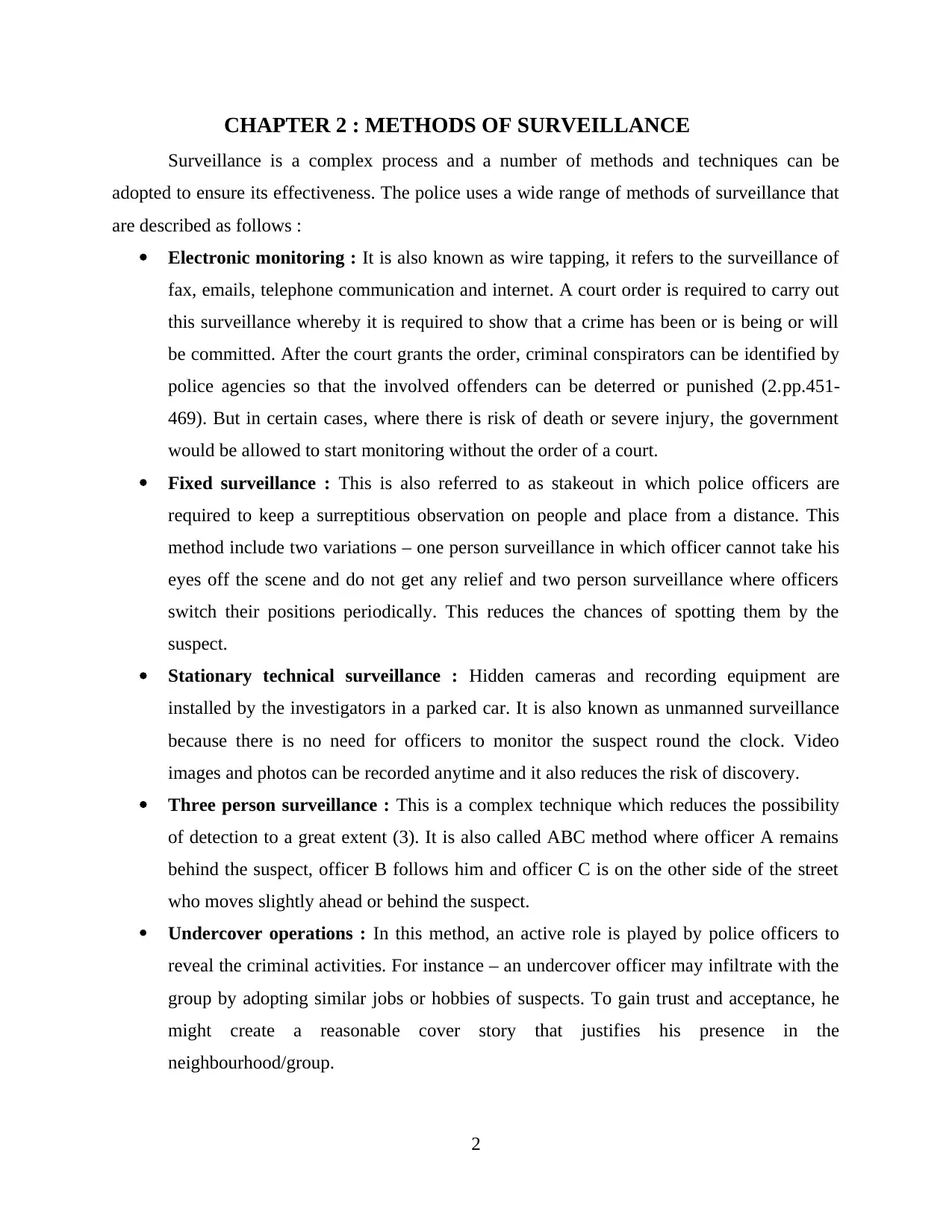
CHAPTER 2 : METHODS OF SURVEILLANCE
Surveillance is a complex process and a number of methods and techniques can be
adopted to ensure its effectiveness. The police uses a wide range of methods of surveillance that
are described as follows :
Electronic monitoring : It is also known as wire tapping, it refers to the surveillance of
fax, emails, telephone communication and internet. A court order is required to carry out
this surveillance whereby it is required to show that a crime has been or is being or will
be committed. After the court grants the order, criminal conspirators can be identified by
police agencies so that the involved offenders can be deterred or punished (2.pp.451-
469). But in certain cases, where there is risk of death or severe injury, the government
would be allowed to start monitoring without the order of a court.
Fixed surveillance : This is also referred to as stakeout in which police officers are
required to keep a surreptitious observation on people and place from a distance. This
method include two variations – one person surveillance in which officer cannot take his
eyes off the scene and do not get any relief and two person surveillance where officers
switch their positions periodically. This reduces the chances of spotting them by the
suspect.
Stationary technical surveillance : Hidden cameras and recording equipment are
installed by the investigators in a parked car. It is also known as unmanned surveillance
because there is no need for officers to monitor the suspect round the clock. Video
images and photos can be recorded anytime and it also reduces the risk of discovery.
Three person surveillance : This is a complex technique which reduces the possibility
of detection to a great extent (3). It is also called ABC method where officer A remains
behind the suspect, officer B follows him and officer C is on the other side of the street
who moves slightly ahead or behind the suspect.
Undercover operations : In this method, an active role is played by police officers to
reveal the criminal activities. For instance – an undercover officer may infiltrate with the
group by adopting similar jobs or hobbies of suspects. To gain trust and acceptance, he
might create a reasonable cover story that justifies his presence in the
neighbourhood/group.
2
Surveillance is a complex process and a number of methods and techniques can be
adopted to ensure its effectiveness. The police uses a wide range of methods of surveillance that
are described as follows :
Electronic monitoring : It is also known as wire tapping, it refers to the surveillance of
fax, emails, telephone communication and internet. A court order is required to carry out
this surveillance whereby it is required to show that a crime has been or is being or will
be committed. After the court grants the order, criminal conspirators can be identified by
police agencies so that the involved offenders can be deterred or punished (2.pp.451-
469). But in certain cases, where there is risk of death or severe injury, the government
would be allowed to start monitoring without the order of a court.
Fixed surveillance : This is also referred to as stakeout in which police officers are
required to keep a surreptitious observation on people and place from a distance. This
method include two variations – one person surveillance in which officer cannot take his
eyes off the scene and do not get any relief and two person surveillance where officers
switch their positions periodically. This reduces the chances of spotting them by the
suspect.
Stationary technical surveillance : Hidden cameras and recording equipment are
installed by the investigators in a parked car. It is also known as unmanned surveillance
because there is no need for officers to monitor the suspect round the clock. Video
images and photos can be recorded anytime and it also reduces the risk of discovery.
Three person surveillance : This is a complex technique which reduces the possibility
of detection to a great extent (3). It is also called ABC method where officer A remains
behind the suspect, officer B follows him and officer C is on the other side of the street
who moves slightly ahead or behind the suspect.
Undercover operations : In this method, an active role is played by police officers to
reveal the criminal activities. For instance – an undercover officer may infiltrate with the
group by adopting similar jobs or hobbies of suspects. To gain trust and acceptance, he
might create a reasonable cover story that justifies his presence in the
neighbourhood/group.
2
Paraphrase This Document
Need a fresh take? Get an instant paraphrase of this document with our AI Paraphraser
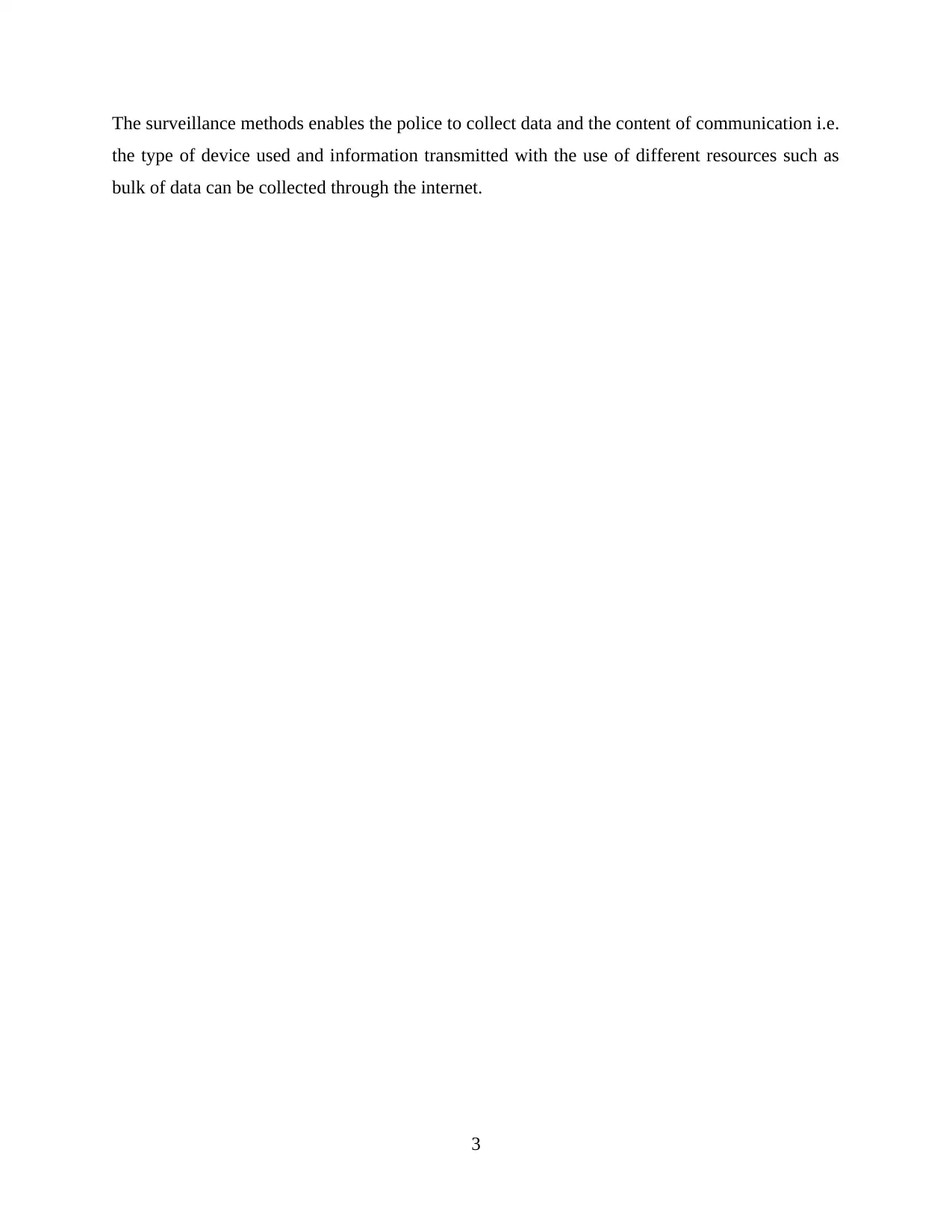
The surveillance methods enables the police to collect data and the content of communication i.e.
the type of device used and information transmitted with the use of different resources such as
bulk of data can be collected through the internet.
3
the type of device used and information transmitted with the use of different resources such as
bulk of data can be collected through the internet.
3
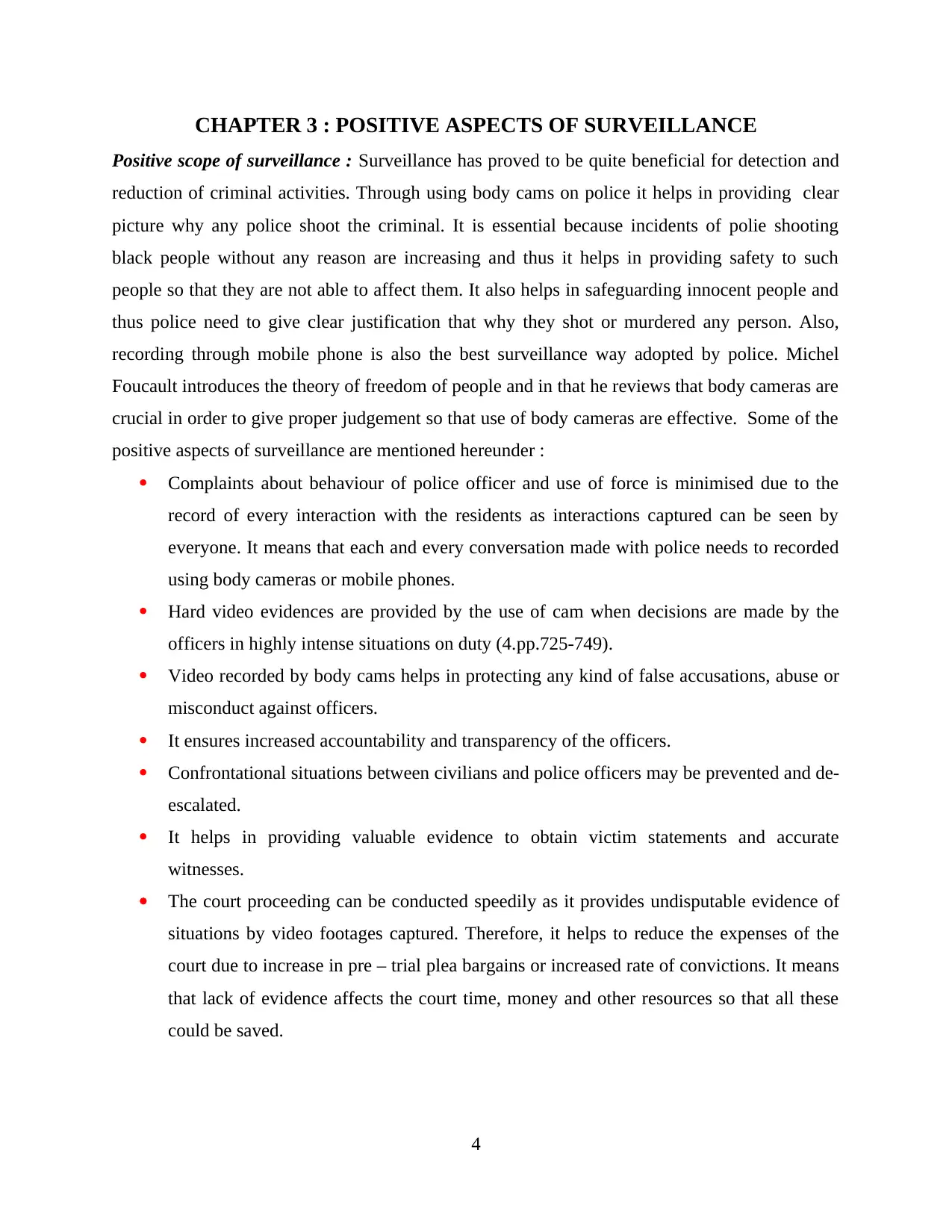
CHAPTER 3 : POSITIVE ASPECTS OF SURVEILLANCE
Positive scope of surveillance : Surveillance has proved to be quite beneficial for detection and
reduction of criminal activities. Through using body cams on police it helps in providing clear
picture why any police shoot the criminal. It is essential because incidents of polie shooting
black people without any reason are increasing and thus it helps in providing safety to such
people so that they are not able to affect them. It also helps in safeguarding innocent people and
thus police need to give clear justification that why they shot or murdered any person. Also,
recording through mobile phone is also the best surveillance way adopted by police. Michel
Foucault introduces the theory of freedom of people and in that he reviews that body cameras are
crucial in order to give proper judgement so that use of body cameras are effective. Some of the
positive aspects of surveillance are mentioned hereunder :
Complaints about behaviour of police officer and use of force is minimised due to the
record of every interaction with the residents as interactions captured can be seen by
everyone. It means that each and every conversation made with police needs to recorded
using body cameras or mobile phones.
Hard video evidences are provided by the use of cam when decisions are made by the
officers in highly intense situations on duty (4.pp.725-749).
Video recorded by body cams helps in protecting any kind of false accusations, abuse or
misconduct against officers.
It ensures increased accountability and transparency of the officers.
Confrontational situations between civilians and police officers may be prevented and de-
escalated.
It helps in providing valuable evidence to obtain victim statements and accurate
witnesses.
The court proceeding can be conducted speedily as it provides undisputable evidence of
situations by video footages captured. Therefore, it helps to reduce the expenses of the
court due to increase in pre – trial plea bargains or increased rate of convictions. It means
that lack of evidence affects the court time, money and other resources so that all these
could be saved.
4
Positive scope of surveillance : Surveillance has proved to be quite beneficial for detection and
reduction of criminal activities. Through using body cams on police it helps in providing clear
picture why any police shoot the criminal. It is essential because incidents of polie shooting
black people without any reason are increasing and thus it helps in providing safety to such
people so that they are not able to affect them. It also helps in safeguarding innocent people and
thus police need to give clear justification that why they shot or murdered any person. Also,
recording through mobile phone is also the best surveillance way adopted by police. Michel
Foucault introduces the theory of freedom of people and in that he reviews that body cameras are
crucial in order to give proper judgement so that use of body cameras are effective. Some of the
positive aspects of surveillance are mentioned hereunder :
Complaints about behaviour of police officer and use of force is minimised due to the
record of every interaction with the residents as interactions captured can be seen by
everyone. It means that each and every conversation made with police needs to recorded
using body cameras or mobile phones.
Hard video evidences are provided by the use of cam when decisions are made by the
officers in highly intense situations on duty (4.pp.725-749).
Video recorded by body cams helps in protecting any kind of false accusations, abuse or
misconduct against officers.
It ensures increased accountability and transparency of the officers.
Confrontational situations between civilians and police officers may be prevented and de-
escalated.
It helps in providing valuable evidence to obtain victim statements and accurate
witnesses.
The court proceeding can be conducted speedily as it provides undisputable evidence of
situations by video footages captured. Therefore, it helps to reduce the expenses of the
court due to increase in pre – trial plea bargains or increased rate of convictions. It means
that lack of evidence affects the court time, money and other resources so that all these
could be saved.
4
⊘ This is a preview!⊘
Do you want full access?
Subscribe today to unlock all pages.

Trusted by 1+ million students worldwide

There are different cases which has been solved by surveillance cameras and thus it helps
police and court to be used as a main evidence. Therefore, use of CCTV footages also helps in
solving cases for police.
5
police and court to be used as a main evidence. Therefore, use of CCTV footages also helps in
solving cases for police.
5
Paraphrase This Document
Need a fresh take? Get an instant paraphrase of this document with our AI Paraphraser
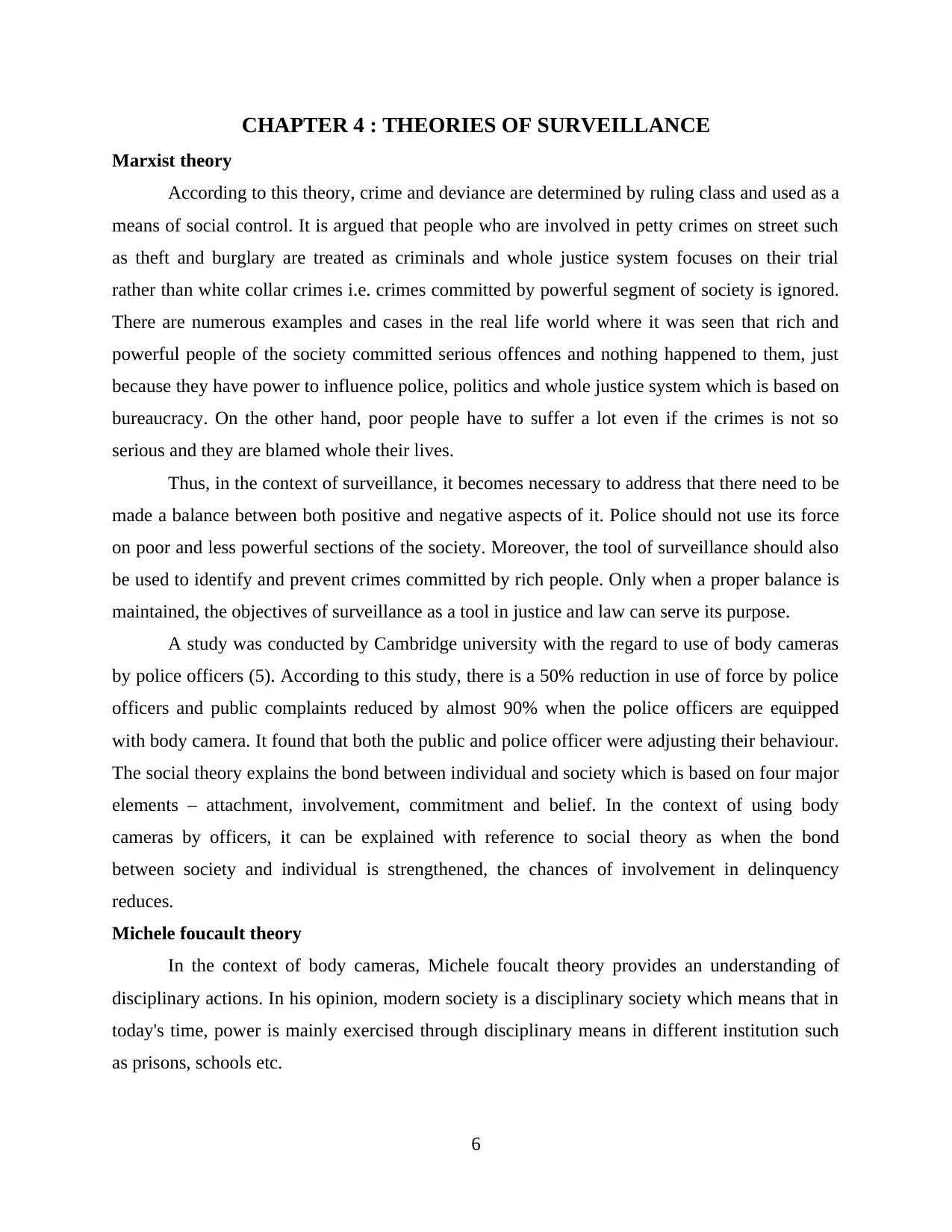
CHAPTER 4 : THEORIES OF SURVEILLANCE
Marxist theory
According to this theory, crime and deviance are determined by ruling class and used as a
means of social control. It is argued that people who are involved in petty crimes on street such
as theft and burglary are treated as criminals and whole justice system focuses on their trial
rather than white collar crimes i.e. crimes committed by powerful segment of society is ignored.
There are numerous examples and cases in the real life world where it was seen that rich and
powerful people of the society committed serious offences and nothing happened to them, just
because they have power to influence police, politics and whole justice system which is based on
bureaucracy. On the other hand, poor people have to suffer a lot even if the crimes is not so
serious and they are blamed whole their lives.
Thus, in the context of surveillance, it becomes necessary to address that there need to be
made a balance between both positive and negative aspects of it. Police should not use its force
on poor and less powerful sections of the society. Moreover, the tool of surveillance should also
be used to identify and prevent crimes committed by rich people. Only when a proper balance is
maintained, the objectives of surveillance as a tool in justice and law can serve its purpose.
A study was conducted by Cambridge university with the regard to use of body cameras
by police officers (5). According to this study, there is a 50% reduction in use of force by police
officers and public complaints reduced by almost 90% when the police officers are equipped
with body camera. It found that both the public and police officer were adjusting their behaviour.
The social theory explains the bond between individual and society which is based on four major
elements – attachment, involvement, commitment and belief. In the context of using body
cameras by officers, it can be explained with reference to social theory as when the bond
between society and individual is strengthened, the chances of involvement in delinquency
reduces.
Michele foucault theory
In the context of body cameras, Michele foucalt theory provides an understanding of
disciplinary actions. In his opinion, modern society is a disciplinary society which means that in
today's time, power is mainly exercised through disciplinary means in different institution such
as prisons, schools etc.
6
Marxist theory
According to this theory, crime and deviance are determined by ruling class and used as a
means of social control. It is argued that people who are involved in petty crimes on street such
as theft and burglary are treated as criminals and whole justice system focuses on their trial
rather than white collar crimes i.e. crimes committed by powerful segment of society is ignored.
There are numerous examples and cases in the real life world where it was seen that rich and
powerful people of the society committed serious offences and nothing happened to them, just
because they have power to influence police, politics and whole justice system which is based on
bureaucracy. On the other hand, poor people have to suffer a lot even if the crimes is not so
serious and they are blamed whole their lives.
Thus, in the context of surveillance, it becomes necessary to address that there need to be
made a balance between both positive and negative aspects of it. Police should not use its force
on poor and less powerful sections of the society. Moreover, the tool of surveillance should also
be used to identify and prevent crimes committed by rich people. Only when a proper balance is
maintained, the objectives of surveillance as a tool in justice and law can serve its purpose.
A study was conducted by Cambridge university with the regard to use of body cameras
by police officers (5). According to this study, there is a 50% reduction in use of force by police
officers and public complaints reduced by almost 90% when the police officers are equipped
with body camera. It found that both the public and police officer were adjusting their behaviour.
The social theory explains the bond between individual and society which is based on four major
elements – attachment, involvement, commitment and belief. In the context of using body
cameras by officers, it can be explained with reference to social theory as when the bond
between society and individual is strengthened, the chances of involvement in delinquency
reduces.
Michele foucault theory
In the context of body cameras, Michele foucalt theory provides an understanding of
disciplinary actions. In his opinion, modern society is a disciplinary society which means that in
today's time, power is mainly exercised through disciplinary means in different institution such
as prisons, schools etc.
6
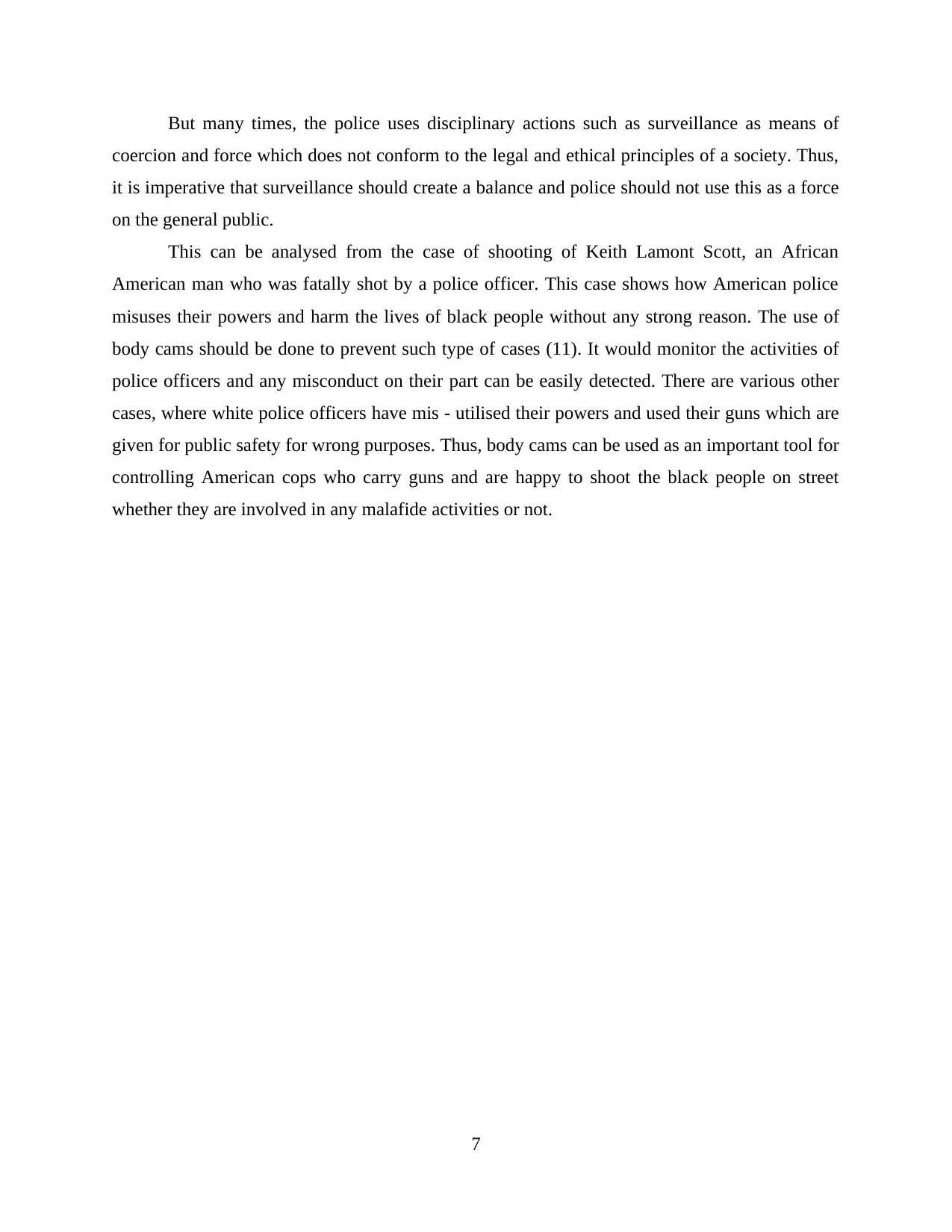
But many times, the police uses disciplinary actions such as surveillance as means of
coercion and force which does not conform to the legal and ethical principles of a society. Thus,
it is imperative that surveillance should create a balance and police should not use this as a force
on the general public.
This can be analysed from the case of shooting of Keith Lamont Scott, an African
American man who was fatally shot by a police officer. This case shows how American police
misuses their powers and harm the lives of black people without any strong reason. The use of
body cams should be done to prevent such type of cases (11). It would monitor the activities of
police officers and any misconduct on their part can be easily detected. There are various other
cases, where white police officers have mis - utilised their powers and used their guns which are
given for public safety for wrong purposes. Thus, body cams can be used as an important tool for
controlling American cops who carry guns and are happy to shoot the black people on street
whether they are involved in any malafide activities or not.
7
coercion and force which does not conform to the legal and ethical principles of a society. Thus,
it is imperative that surveillance should create a balance and police should not use this as a force
on the general public.
This can be analysed from the case of shooting of Keith Lamont Scott, an African
American man who was fatally shot by a police officer. This case shows how American police
misuses their powers and harm the lives of black people without any strong reason. The use of
body cams should be done to prevent such type of cases (11). It would monitor the activities of
police officers and any misconduct on their part can be easily detected. There are various other
cases, where white police officers have mis - utilised their powers and used their guns which are
given for public safety for wrong purposes. Thus, body cams can be used as an important tool for
controlling American cops who carry guns and are happy to shoot the black people on street
whether they are involved in any malafide activities or not.
7
⊘ This is a preview!⊘
Do you want full access?
Subscribe today to unlock all pages.

Trusted by 1+ million students worldwide
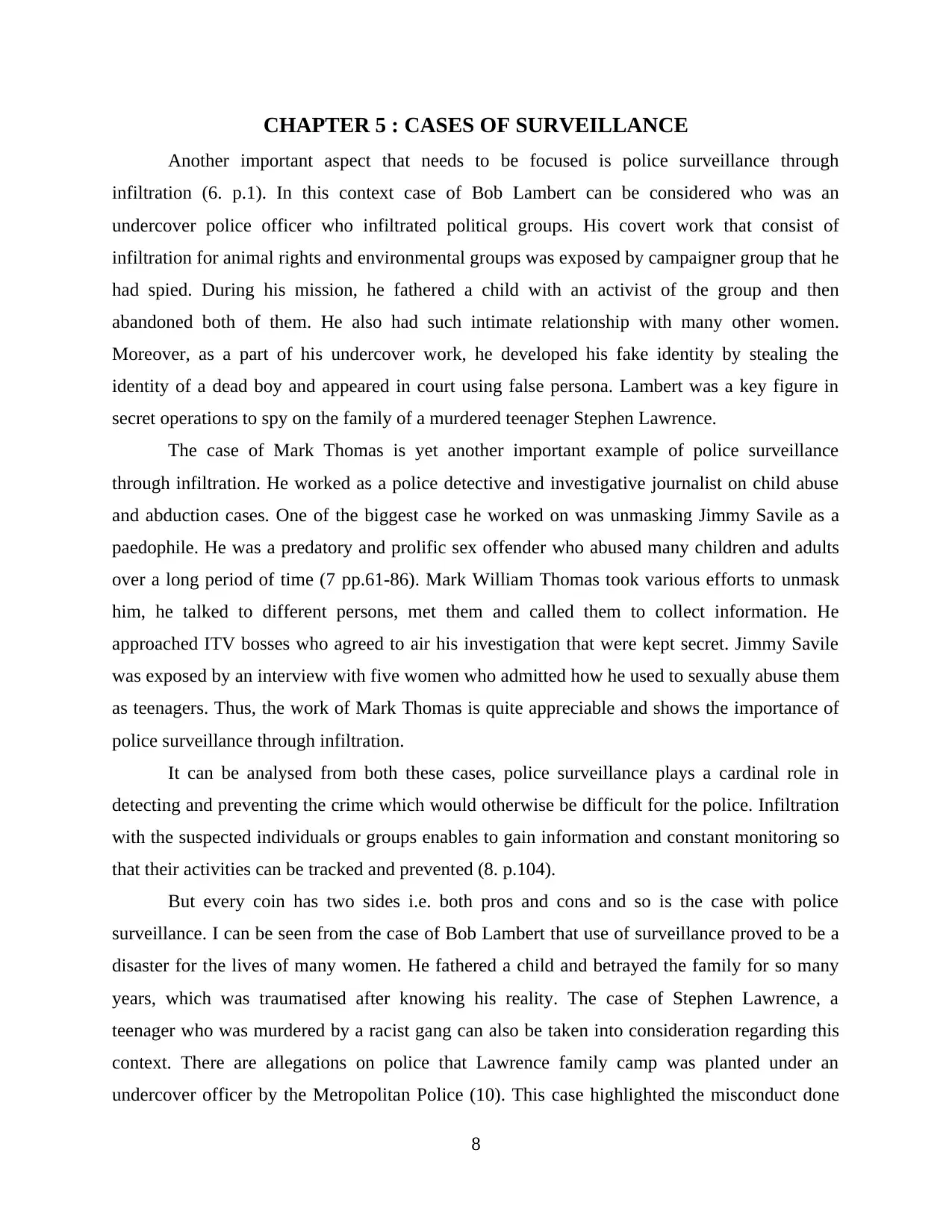
CHAPTER 5 : CASES OF SURVEILLANCE
Another important aspect that needs to be focused is police surveillance through
infiltration (6. p.1). In this context case of Bob Lambert can be considered who was an
undercover police officer who infiltrated political groups. His covert work that consist of
infiltration for animal rights and environmental groups was exposed by campaigner group that he
had spied. During his mission, he fathered a child with an activist of the group and then
abandoned both of them. He also had such intimate relationship with many other women.
Moreover, as a part of his undercover work, he developed his fake identity by stealing the
identity of a dead boy and appeared in court using false persona. Lambert was a key figure in
secret operations to spy on the family of a murdered teenager Stephen Lawrence.
The case of Mark Thomas is yet another important example of police surveillance
through infiltration. He worked as a police detective and investigative journalist on child abuse
and abduction cases. One of the biggest case he worked on was unmasking Jimmy Savile as a
paedophile. He was a predatory and prolific sex offender who abused many children and adults
over a long period of time (7 pp.61-86). Mark William Thomas took various efforts to unmask
him, he talked to different persons, met them and called them to collect information. He
approached ITV bosses who agreed to air his investigation that were kept secret. Jimmy Savile
was exposed by an interview with five women who admitted how he used to sexually abuse them
as teenagers. Thus, the work of Mark Thomas is quite appreciable and shows the importance of
police surveillance through infiltration.
It can be analysed from both these cases, police surveillance plays a cardinal role in
detecting and preventing the crime which would otherwise be difficult for the police. Infiltration
with the suspected individuals or groups enables to gain information and constant monitoring so
that their activities can be tracked and prevented (8. p.104).
But every coin has two sides i.e. both pros and cons and so is the case with police
surveillance. I can be seen from the case of Bob Lambert that use of surveillance proved to be a
disaster for the lives of many women. He fathered a child and betrayed the family for so many
years, which was traumatised after knowing his reality. The case of Stephen Lawrence, a
teenager who was murdered by a racist gang can also be taken into consideration regarding this
context. There are allegations on police that Lawrence family camp was planted under an
undercover officer by the Metropolitan Police (10). This case highlighted the misconduct done
8
Another important aspect that needs to be focused is police surveillance through
infiltration (6. p.1). In this context case of Bob Lambert can be considered who was an
undercover police officer who infiltrated political groups. His covert work that consist of
infiltration for animal rights and environmental groups was exposed by campaigner group that he
had spied. During his mission, he fathered a child with an activist of the group and then
abandoned both of them. He also had such intimate relationship with many other women.
Moreover, as a part of his undercover work, he developed his fake identity by stealing the
identity of a dead boy and appeared in court using false persona. Lambert was a key figure in
secret operations to spy on the family of a murdered teenager Stephen Lawrence.
The case of Mark Thomas is yet another important example of police surveillance
through infiltration. He worked as a police detective and investigative journalist on child abuse
and abduction cases. One of the biggest case he worked on was unmasking Jimmy Savile as a
paedophile. He was a predatory and prolific sex offender who abused many children and adults
over a long period of time (7 pp.61-86). Mark William Thomas took various efforts to unmask
him, he talked to different persons, met them and called them to collect information. He
approached ITV bosses who agreed to air his investigation that were kept secret. Jimmy Savile
was exposed by an interview with five women who admitted how he used to sexually abuse them
as teenagers. Thus, the work of Mark Thomas is quite appreciable and shows the importance of
police surveillance through infiltration.
It can be analysed from both these cases, police surveillance plays a cardinal role in
detecting and preventing the crime which would otherwise be difficult for the police. Infiltration
with the suspected individuals or groups enables to gain information and constant monitoring so
that their activities can be tracked and prevented (8. p.104).
But every coin has two sides i.e. both pros and cons and so is the case with police
surveillance. I can be seen from the case of Bob Lambert that use of surveillance proved to be a
disaster for the lives of many women. He fathered a child and betrayed the family for so many
years, which was traumatised after knowing his reality. The case of Stephen Lawrence, a
teenager who was murdered by a racist gang can also be taken into consideration regarding this
context. There are allegations on police that Lawrence family camp was planted under an
undercover officer by the Metropolitan Police (10). This case highlighted the misconduct done
8
Paraphrase This Document
Need a fresh take? Get an instant paraphrase of this document with our AI Paraphraser
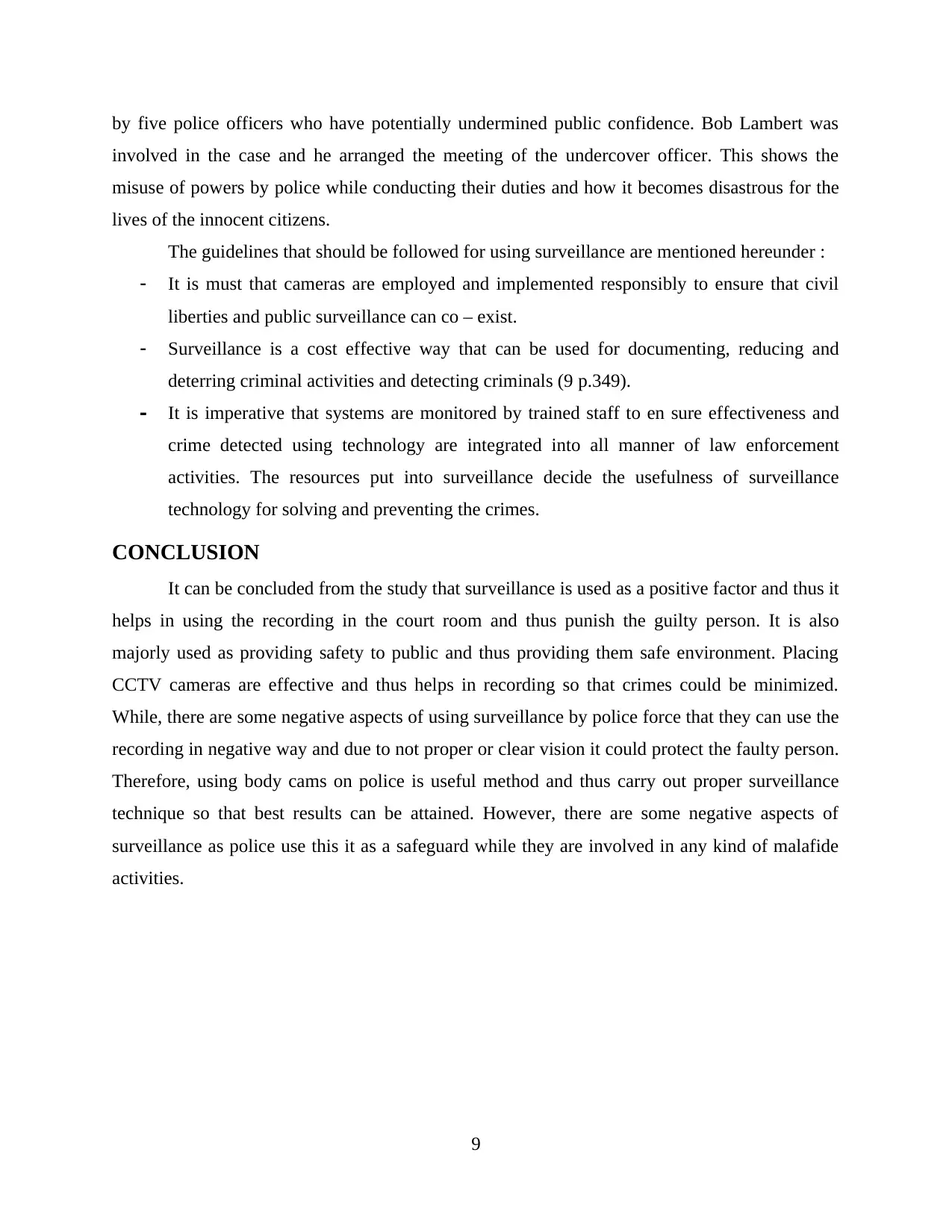
by five police officers who have potentially undermined public confidence. Bob Lambert was
involved in the case and he arranged the meeting of the undercover officer. This shows the
misuse of powers by police while conducting their duties and how it becomes disastrous for the
lives of the innocent citizens.
The guidelines that should be followed for using surveillance are mentioned hereunder :
It is must that cameras are employed and implemented responsibly to ensure that civil
liberties and public surveillance can co – exist.
Surveillance is a cost effective way that can be used for documenting, reducing and
deterring criminal activities and detecting criminals (9 p.349).
It is imperative that systems are monitored by trained staff to en sure effectiveness and
crime detected using technology are integrated into all manner of law enforcement
activities. The resources put into surveillance decide the usefulness of surveillance
technology for solving and preventing the crimes.
CONCLUSION
It can be concluded from the study that surveillance is used as a positive factor and thus it
helps in using the recording in the court room and thus punish the guilty person. It is also
majorly used as providing safety to public and thus providing them safe environment. Placing
CCTV cameras are effective and thus helps in recording so that crimes could be minimized.
While, there are some negative aspects of using surveillance by police force that they can use the
recording in negative way and due to not proper or clear vision it could protect the faulty person.
Therefore, using body cams on police is useful method and thus carry out proper surveillance
technique so that best results can be attained. However, there are some negative aspects of
surveillance as police use this it as a safeguard while they are involved in any kind of malafide
activities.
9
involved in the case and he arranged the meeting of the undercover officer. This shows the
misuse of powers by police while conducting their duties and how it becomes disastrous for the
lives of the innocent citizens.
The guidelines that should be followed for using surveillance are mentioned hereunder :
It is must that cameras are employed and implemented responsibly to ensure that civil
liberties and public surveillance can co – exist.
Surveillance is a cost effective way that can be used for documenting, reducing and
deterring criminal activities and detecting criminals (9 p.349).
It is imperative that systems are monitored by trained staff to en sure effectiveness and
crime detected using technology are integrated into all manner of law enforcement
activities. The resources put into surveillance decide the usefulness of surveillance
technology for solving and preventing the crimes.
CONCLUSION
It can be concluded from the study that surveillance is used as a positive factor and thus it
helps in using the recording in the court room and thus punish the guilty person. It is also
majorly used as providing safety to public and thus providing them safe environment. Placing
CCTV cameras are effective and thus helps in recording so that crimes could be minimized.
While, there are some negative aspects of using surveillance by police force that they can use the
recording in negative way and due to not proper or clear vision it could protect the faulty person.
Therefore, using body cams on police is useful method and thus carry out proper surveillance
technique so that best results can be attained. However, there are some negative aspects of
surveillance as police use this it as a safeguard while they are involved in any kind of malafide
activities.
9
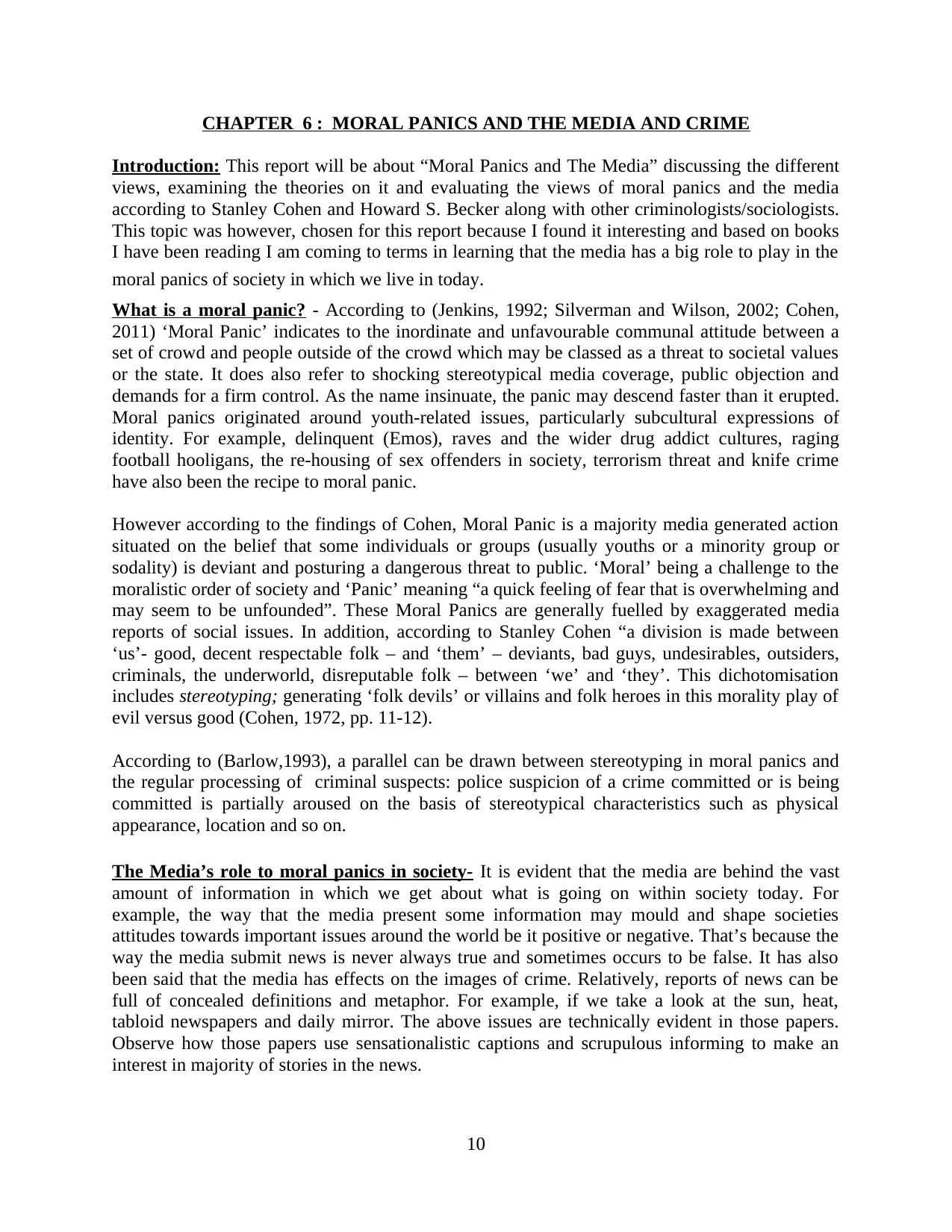
CHAPTER 6 : MORAL PANICS AND THE MEDIA AND CRIME
Introduction: This report will be about “Moral Panics and The Media” discussing the different
views, examining the theories on it and evaluating the views of moral panics and the media
according to Stanley Cohen and Howard S. Becker along with other criminologists/sociologists.
This topic was however, chosen for this report because I found it interesting and based on books
I have been reading I am coming to terms in learning that the media has a big role to play in the
moral panics of society in which we live in today.
What is a moral panic? - According to (Jenkins, 1992; Silverman and Wilson, 2002; Cohen,
2011) ‘Moral Panic’ indicates to the inordinate and unfavourable communal attitude between a
set of crowd and people outside of the crowd which may be classed as a threat to societal values
or the state. It does also refer to shocking stereotypical media coverage, public objection and
demands for a firm control. As the name insinuate, the panic may descend faster than it erupted.
Moral panics originated around youth-related issues, particularly subcultural expressions of
identity. For example, delinquent (Emos), raves and the wider drug addict cultures, raging
football hooligans, the re-housing of sex offenders in society, terrorism threat and knife crime
have also been the recipe to moral panic.
However according to the findings of Cohen, Moral Panic is a majority media generated action
situated on the belief that some individuals or groups (usually youths or a minority group or
sodality) is deviant and posturing a dangerous threat to public. ‘Moral’ being a challenge to the
moralistic order of society and ‘Panic’ meaning “a quick feeling of fear that is overwhelming and
may seem to be unfounded”. These Moral Panics are generally fuelled by exaggerated media
reports of social issues. In addition, according to Stanley Cohen “a division is made between
‘us’- good, decent respectable folk – and ‘them’ – deviants, bad guys, undesirables, outsiders,
criminals, the underworld, disreputable folk – between ‘we’ and ‘they’. This dichotomisation
includes stereotyping; generating ‘folk devils’ or villains and folk heroes in this morality play of
evil versus good (Cohen, 1972, pp. 11-12).
According to (Barlow,1993), a parallel can be drawn between stereotyping in moral panics and
the regular processing of criminal suspects: police suspicion of a crime committed or is being
committed is partially aroused on the basis of stereotypical characteristics such as physical
appearance, location and so on.
The Media’s role to moral panics in society- It is evident that the media are behind the vast
amount of information in which we get about what is going on within society today. For
example, the way that the media present some information may mould and shape societies
attitudes towards important issues around the world be it positive or negative. That’s because the
way the media submit news is never always true and sometimes occurs to be false. It has also
been said that the media has effects on the images of crime. Relatively, reports of news can be
full of concealed definitions and metaphor. For example, if we take a look at the sun, heat,
tabloid newspapers and daily mirror. The above issues are technically evident in those papers.
Observe how those papers use sensationalistic captions and scrupulous informing to make an
interest in majority of stories in the news.
10
Introduction: This report will be about “Moral Panics and The Media” discussing the different
views, examining the theories on it and evaluating the views of moral panics and the media
according to Stanley Cohen and Howard S. Becker along with other criminologists/sociologists.
This topic was however, chosen for this report because I found it interesting and based on books
I have been reading I am coming to terms in learning that the media has a big role to play in the
moral panics of society in which we live in today.
What is a moral panic? - According to (Jenkins, 1992; Silverman and Wilson, 2002; Cohen,
2011) ‘Moral Panic’ indicates to the inordinate and unfavourable communal attitude between a
set of crowd and people outside of the crowd which may be classed as a threat to societal values
or the state. It does also refer to shocking stereotypical media coverage, public objection and
demands for a firm control. As the name insinuate, the panic may descend faster than it erupted.
Moral panics originated around youth-related issues, particularly subcultural expressions of
identity. For example, delinquent (Emos), raves and the wider drug addict cultures, raging
football hooligans, the re-housing of sex offenders in society, terrorism threat and knife crime
have also been the recipe to moral panic.
However according to the findings of Cohen, Moral Panic is a majority media generated action
situated on the belief that some individuals or groups (usually youths or a minority group or
sodality) is deviant and posturing a dangerous threat to public. ‘Moral’ being a challenge to the
moralistic order of society and ‘Panic’ meaning “a quick feeling of fear that is overwhelming and
may seem to be unfounded”. These Moral Panics are generally fuelled by exaggerated media
reports of social issues. In addition, according to Stanley Cohen “a division is made between
‘us’- good, decent respectable folk – and ‘them’ – deviants, bad guys, undesirables, outsiders,
criminals, the underworld, disreputable folk – between ‘we’ and ‘they’. This dichotomisation
includes stereotyping; generating ‘folk devils’ or villains and folk heroes in this morality play of
evil versus good (Cohen, 1972, pp. 11-12).
According to (Barlow,1993), a parallel can be drawn between stereotyping in moral panics and
the regular processing of criminal suspects: police suspicion of a crime committed or is being
committed is partially aroused on the basis of stereotypical characteristics such as physical
appearance, location and so on.
The Media’s role to moral panics in society- It is evident that the media are behind the vast
amount of information in which we get about what is going on within society today. For
example, the way that the media present some information may mould and shape societies
attitudes towards important issues around the world be it positive or negative. That’s because the
way the media submit news is never always true and sometimes occurs to be false. It has also
been said that the media has effects on the images of crime. Relatively, reports of news can be
full of concealed definitions and metaphor. For example, if we take a look at the sun, heat,
tabloid newspapers and daily mirror. The above issues are technically evident in those papers.
Observe how those papers use sensationalistic captions and scrupulous informing to make an
interest in majority of stories in the news.
10
⊘ This is a preview!⊘
Do you want full access?
Subscribe today to unlock all pages.

Trusted by 1+ million students worldwide
1 out of 105
Your All-in-One AI-Powered Toolkit for Academic Success.
+13062052269
info@desklib.com
Available 24*7 on WhatsApp / Email
![[object Object]](/_next/static/media/star-bottom.7253800d.svg)
Unlock your academic potential
Copyright © 2020–2025 A2Z Services. All Rights Reserved. Developed and managed by ZUCOL.

